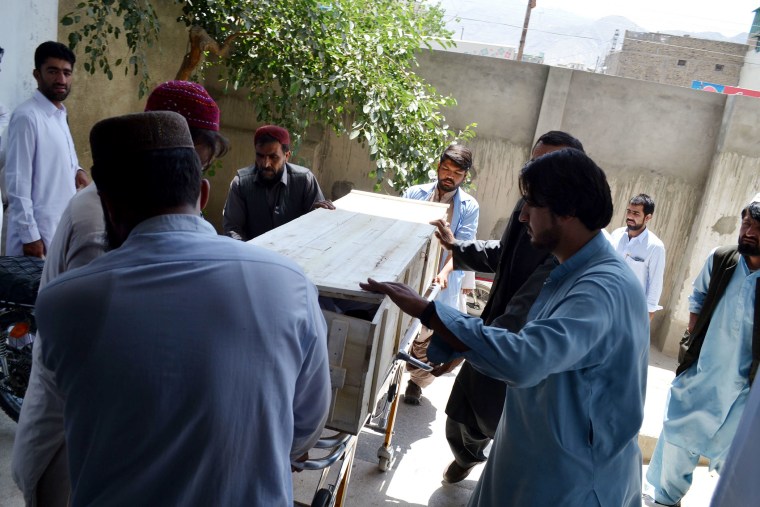The leader of the Taliban has been killed in a U.S. airstrike, Afghanistan's government confirmed Sunday, setting up a potential succession showdown in the deeply-divided insurgent group.
A statement from the National Directorate of Security was the first official confirmation of Mullah Akhtar Mansoor's death. It was soon followed by confirmation from Afghanistan's chief executive — but no acknowledgement from the Taliban.
The U.S. conducted a precision airstrike targeting Mansoor on Saturday in a remote part of southwest Pakistan. Pentagon spokesman Peter Cook had said the U.S. was "still assessing the results" of the strikes, though senior defense officials told NBC News that Mansoor was "likely killed."
Afghanistan's National Directorate of Security issued a statement on Sunday announcing Mansour had died in a strike in southwestern Pakistan's Baluchistan province.
The drone strike hit Mansoor's car in Quetta, Afghanistan's Chief Executive Abdullah Abdullah added.
Meanwhile, in Pakistan, the country's Ministry of Foreign Affairs called the drone strike "a violation of [the state's] sovereignty," after revealing in a statement the country was informed of the strike by the United States only after the fact.
Pakistan's government did not specifically acknowledge Mansoor's killing, stating instead that a vehicle was found destroyed along the border with Afghanistan.

The statement said the driver's name was Muhammad Azam, whose body was identified and collected by his relatives. A second person is believed to be Wali Muhammad, who was "carrying a Pakistani passport ... bearing a valid Iranian visa."
There have been previous rumors and reports about Mansoor's demise prior to Saturday's operation. There has been no formal statement from the Taliban since the announcement of the strikes targeting Mansoor.However, the identity of the second body in the car "is [still] being verified on the basis of evidence found at the site of the incident and other relevant information," the statement added.
However, the group has been experiencing rift's since the death of its founder was announced last year — a development Mansoor had kept hidden for two years.
The Taliban shura reportedly discussed options for a successor for Mansoor, including Mullah Omar's son, Mullah Mohammad Yaqoob, former Guantanamo Bay detainee Mullah Abdul Qayyum Zakir, Mullah Sherin and Sirajuddin Haqqani aka Khaleefa.
While not openly acknowledging Mansoor's death, senior members of the militant network reportedly called an emergency meeting of the leadership council.
"Though Mullah Omar's son, Mullah Yaqoob, is very young, some people wanted him to replace Mullah Mansour as it will unite different factions. Some wanted to appoint Sirajuddin Haqqani to defy the U.S. and Afghan government, to seek the revenge of Mullah Mansour's killing," said a senior Taliban member.
Pleading anonymity, he said the shura would continue its meeting on Monday and may prolong the session if they don't reach consensus about one person.
While U.S. officials have not publicly confirmed the Taliban leader's death, Secretary of State John Kerry repeatedly referred to Mansoor in the past tense on Sunday.
He said Mansoor "posed a continuing imminent threat" to U.S. personnel in Afghanistan, to Afghans and to peace.

"Peace is what we want. Mansoor was a threat to that effort and to bringing an end to the violence and suffering people of Afghanistan have endured for so many years now," Kerry said.
Kerry told a news conference in Myanmar that the leaders of both Pakistan and Afghanistan were notified of the operation but he declined to elaborate on the timing of the notifications.
Mansour was publicly named the head of the militant organization soon after it emerged in July that the Taliban's leader, Mullah Omar, had actually been dead for two years.
One Taliban commander told NBC News that members of the insurgent group were calling an emergency meeting of its leadership council to address reports of Mansoor's death.
"All our members are in the state of shock and anger over what they are hearing from media," the commander said, requesting anonymity. "Everybody in our movement is asking one question whether Mullah Mansoor has really been killed."
According to an official Taliban release, Mansoor was born in 1965 in the southern province of Kandahar and had two wives.
According to the the militants, Mansoor started his militant career in 1979 during the Soviet occupation of Afghanistan by joining a religious-cum-jihadi organization, Harakat-e Inqilab-e Islami.
This story first appeared on NBCNews.com.